Bolshevik: Bolshevik is an optional and often used additional rule in the game of Skruuvi. It was a fairly early addition to the game, being introduced in the early 1920's. Bolshevik is an additional hand type that is included with the standard game. The Bolshevik add-on should not be played unless all four players agree to it's inclusion before the start of play.
After the normal 24 hands are played, exactly as described above, before the game ends, each player must play one additional hand at Bolshevik. A hand of Bolshevik is played as follows:
The current dealer deals the hands as if playing a kitty game, dealing each player 12 cards and a four card face-down kitty to the center of the table. The player to the immediate left of the dealer then has the first opportunity to bid Bolshevik or pass. There is one round of bidding, with each player allowed to bid Bolshevik or pass. If all four players pass, with no player bidding Bolshevik, the cards are gathered, reshuffled and passed to the next dealer in a clockwise direction. However, if a player has not bid Bolshevik on his past eight bids, he must make the bid of Bolshevik whether he wants to or not.
If only one player bids Bolshevik, the bidding ends and the hand begins. However, if two or more players bid Bolshevik, the first player to so bid can decide if he wants to be the declarer on the hand or pass. This rotates in turn around the table amongst the players who bid Bolshevik. If all previous players who originally bid Bolshevik on the hand decline, the last player to have bid Bolshevik on the hand must play.
The declaring player must then play solo against the other three players.
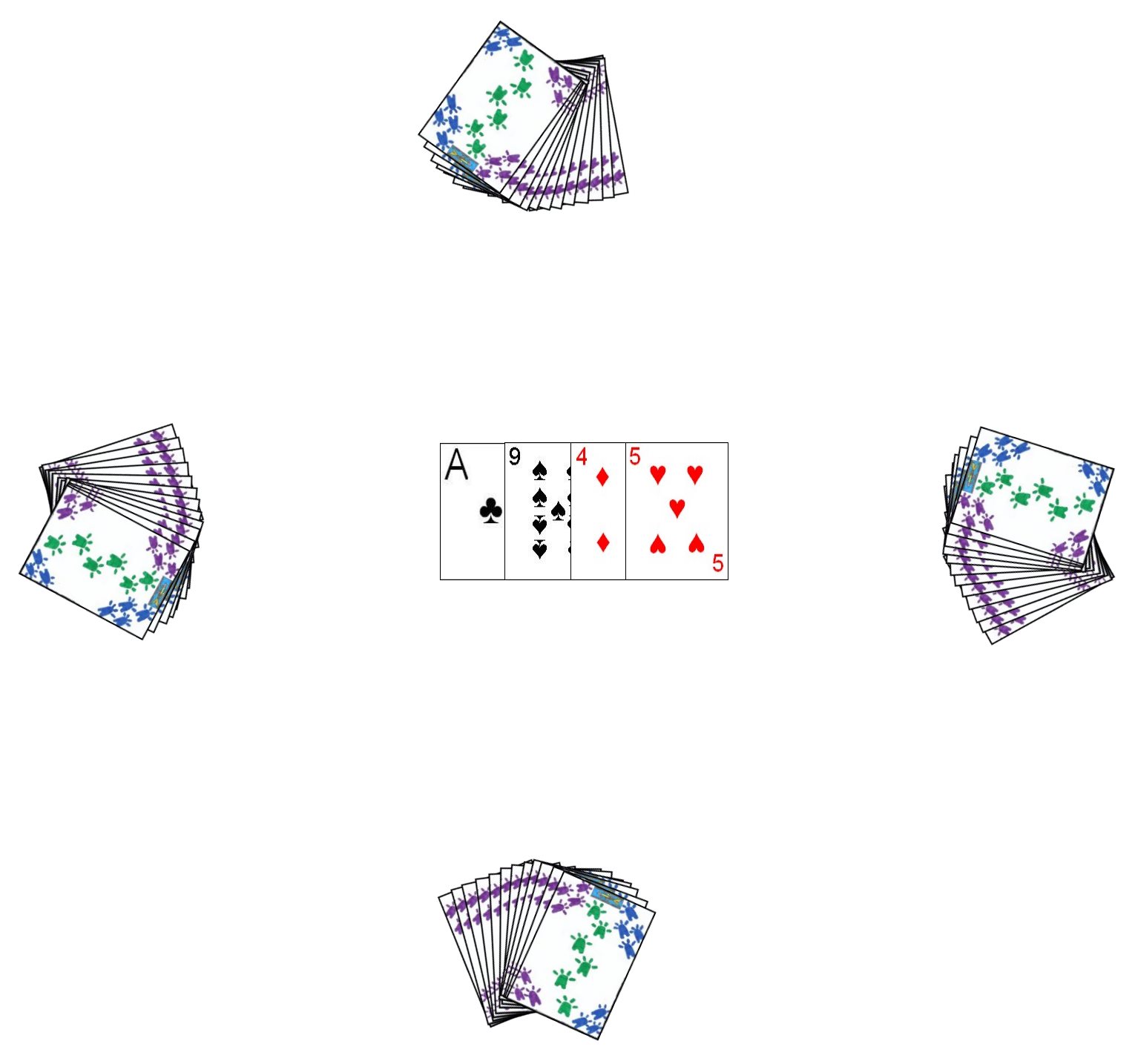
The player who bid Bolshevik then turns over the four card kitty for all to see. After doing this he adds the cards to his own hand and then passes one card of his choice from his hand, face-down to each other player starting with the player to his immediate left. The Bolshevik bidding player then has two options, he may either continue play (standard Bolshevik), playing the hand at seven misère. However, he also has the option to increase the bid to seven (called Dictator) declaring a trump suit of his choice (or no-trump) and plays as if playing at a bid of seven using that trump suit.
The player to the immediate right of this declarer then has the first opportunity to double the bid. As opposed to the regular hands, when playing the Bolshevik hand, each player's double only applies to his own score (and the Bolshevik bidders). Thus, each player may double independently of the other players. For each player who doubled during this round, the declarer can opt to re-double that player. A double multiplies all scores by two for that player during the hand. This scoring also applies to the Bolshevik player when calculating any score based on this opponent. Similarly, if the Bolshevik bidder elect to redouble that player, this multiplies all scores as calculated amongst that opponent and the high bidder by three. As in the standard hand types, this doubling and redoubling does not effect the score for Aces captured during a misère hand.
The play of the hand is played identically to the standard game, with the player to the immediate right of the Bolshevik player making the first lead to the first trick.
Scores and penalties earned during the Bolshevik rounds should be temporarily scored on a different scoresheet for each player, as the scores in this round are actually calculated per individual and are based on scoring amongst that opponent and the Bolshevik bidder. If the Bolshevik player manages to make his contract he scores 20 points in misère for each opponent (so a total of 60 points), while each opponent must subtract 20 points from his own score sheet. If he plays the hand at Dictator, he scores 50 points for each opponent (a total of 150 points) and each opponent subtracts 50 points from his own score. If the player does not manage to make his contract, each opponent scores 15 points for the first undertrick and 5 points for each subsequent undertrick in which the declarer won less (or more) than required, while the declarer subtracts 15 points for each opponent in the game for the first trick and 5 points per opponent for each subsequent undertrick. The scores for the Aces won in a misère contract by the bidder are thus subtracted from the bidder (multiplied by three) and that total added to each opponents total.
Since Bolshevik is played by each player independently, the score for the Bolshevik player as well as each opponent is record only on his own scoresheet.
After each player has played one hand bidding Bolshevik, the Bolshevik session ends and the scores for this special session are calculated and recorded to the main game scoresheet. Each players score is totaled and divided by three. If the result is not a whole number, it should be rounded up to the nearest whole number. This score is then added to that player's total score sheet to determine the winner of the overall game.
Vint
Vint is a Russian Card game which contains elements of both Bridge and Whist. This is the game from which Skruuvi developed and bears many similarities to that game. Vint was at one time very popular in many areas of Russia and was considered the National Card game of the
Russian nation during that time. Although Vint is must less rarely played currently, there are still some
adherents in the area and the game can also be occasionally found in other areas of the World as well. Due to the similarities to that game, Vint is sometimes called Russian Whist and developed from an older game called Siberia.
Vint is designed to be played by four players in two partnerships. The game uses the standard 52 card deck, with the following ranking (from high to low); Ace, King, Queen, Jack, 10, 9, 8, 7, 6, 5, 4, 3, 2. For bidding purposes, the suits in the deck also have a ranking as follows (from high to low); Hearts, Diamonds, Clubs, Spades.
A variety of methods can be used to determine partnerships, with a common method having each player draw a card, with the two highest ranked cards playing as partners against the players drawing the two lowest. Partners should directly across the table from each other when playing the game. The first dealer will usually be the player drawing the highest ranked card of all.
After partnerships have been selected and the players seated, the dealer should thoroughly shuffle the deck and pass it to the player at his immediate left to cut. After the cut, the dealer then begins dealing the cards in a clockwise rotation around the table starting with the player to his immediate left. He deals the cards one-by-one and face down around the table until the entire deck has been dealt.
After the cards have been dealt, the players pick up their cards and the bidding round begins. The dealer has the first opportunity to bid. A bid is a contract to win a specific number of odd tricks (tricks greater than 7) and also declaring the suit that would be used as trump. The minimum bid is 1 Spades (indicating a bid for that player's partnership to win seven tricks using Spades as the trump suit for the hand. The bidding continues around the table in a clockwise rotation around the table from player to player. A player may either bid or pass. To be valid, a bid must be higher than the last previous high bid. It can be higher in the number of tricks declared, or if a bid of the same number of tricks as the previous high bid, it must be in a higher ranking suit. Instead of a bid in a specific suit, a bid of No Trump can also be declared. This indicates a bid to play the hand with no trump suit set. A bid of No Trump is higher than any other bid of the same number of declared tricks in a specific suit. A player cannot make a bid, if the current high bid was made by himself or his partner.
After three successive passes, the bidding ends, with the player making the last high bid set as declarer for the hand. This player and his partner must then attempt to win at least as many tricks as bid using the trump suit in that bid (or No trump if that was declared instead).
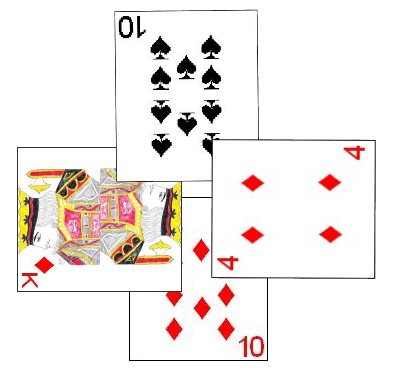
The player to the immediate left of the declarer leads the first card to the first trick. When leading to a trick, a player may lead with any card of his choice remaining in his hand. Each other player, in proper turn, then plays one card to the trick. When playing to a trick, a player must play a card of the same suit as originally played to the trick if he has one. If he does not have such a card he may play any card from his hand including a card of the trump suit.
The highest card of the trump suit played to the trick wins that trick. If no cards of the trump suit have been played to the trick, the highest card of the suit originally played to the trick wins it. The won tricks should be set aside, not to be used further in play of this hand. The winner of each trick leads the first card to the next trick.
Scoring: After all tricks have been played and won, the scoring of the hand begins. There are two kinds of scoring in this game (similar to Contract Bridge); above the line and below the line scoring. Both the declarer's team and the opposing team (the defenders) score for each trick won during the hand. The points scored for each trick are directly dependent on the high bid for the hand. The following chart shows the value for each trick based on the high bid for the hand:
| High Bid | Score per Trick |
|---|
| 1 | 10 Points |
| 2 | 20 Points |
| 3 | 30 Points |
| 4 | 40 Points |
| 5 | 50 Points |
| 6 | 60 Points |
| 7 | 70 Points |
These scores for tricks won are all added to the Below the Line section of the scoresheet. Both partnerships score for won tricks regardless of whether the actual declarer made his bid or not.
The first partnership to accumulate a score of 500 or more. This can be even during the middle of a hand in progress and can be either partnership during the hand.
In addition to the normal scoring, there are special Honor Points which can be awarded during a hand. All honor points are scored in the Above the Line section of the scoresheet.
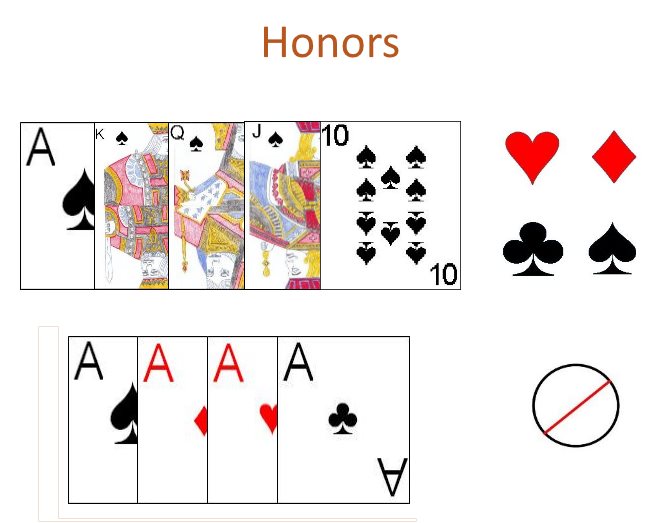
Honor points can be scored for in several ways, including by being dealt honor cards. The honor cards are the Ace, King, Queen, Jack and 10 of the trump suit. In addition, the four Aces are also considered point scoring cards. If the winning bid was at No Trump, there are no specific honor cards, but the four Aces are still considered bonus point scoring cards. In suited bids, note that the Ace of the trump suit can potentially be scored for twice, once as an honor card and once as an Ace.
The honors are divided into two categories, Honor Cards and Aces. Each partnership should first determine the number of Honor Cards and Aces they have been dealt. Whichever total is higher would then be determined to be their total honors for the hand. Then, this total from both partnership should be compared and the partnership which has the higher total is entitled to score for Honors. This partnership scores a number of points equal to the difference between his partnerships Honor Cards they had been dealt and the opposing teams Honor cards they had been dealt, all multiplied by 100. In a hand in which the high bid was of "No Trump", only the four Aces are scored, with the side having been dealt the most Aces scoring a number of points equal to 250 times the number of Aces won in tricks during the current hand.
There are also several additional types of honors that can be scored at the end of a hand:
- For winning a game (scoring 500 points during or at the end of a hand), a partnership wins 1,000 honors points.
- The first partnership to win two games (called a Rubber) earns 2,000 honors points.
- One player, having been dealt a sequence of three cards in the same suit (one being an Ace), scores 500 points. This is called a coronet.
- One player having been dealt three or four Aces (also called a coronet) scores 5000 points.
- Having been dealt the Ace, King and Queen of the same suit (non-trump suit in a suited bid) scores that player 500 points.
Each additional card of the same suit the player was dealt that can be added to the sequence adds 500 more points.
- Being dealt the Ace, King and Queen, all of the trump suit scores a player 1,000 points. Each additional card, in sequence of the trump suit that can be added to the sequence scores 1,000 more.
- Being dealt the Ace, King and Queen, all of the same suit, in a hand with which no trump suit was declared, scores that player 1,000 points. Each additional card, in sequence of that same suit that can be added to the sequence scores 1,000 more.
- Winning 12 tricks (after having bid less than 12) scores that partnership 1,000. This is called a Little Slam.
- Winning 13 tricks (but having bid less than 13) scores that partnership 2,000 points. This is called a Grand Slam.
- Bidding and winning a bid of 12 tricks earns that partnership 6,000 points.
- Bidding 12 tricks and winning 13 tricks earns a partnership 7,000 points.
- Bidding and winning a Grand Slam (bidding for and winning every trick) earns that partnership 12,000 points.
If the declaring team was unable to win at least as many tricks as bid, they
must also record a penalty to their score on the scoresheet (scored Above the
Line). This penalty is two times the normal value of a won trick during the
current hand (as shown on the chart above). The declaring team must subtract
this number for each trick less than the number needed to fulfill his
declaration for the hand.
Much like Bridge, after the completion of three games, the team with the higher score is declared the overall winner of the game.
Copyright © 2015 CatsAtCards.com. All rights reserved.


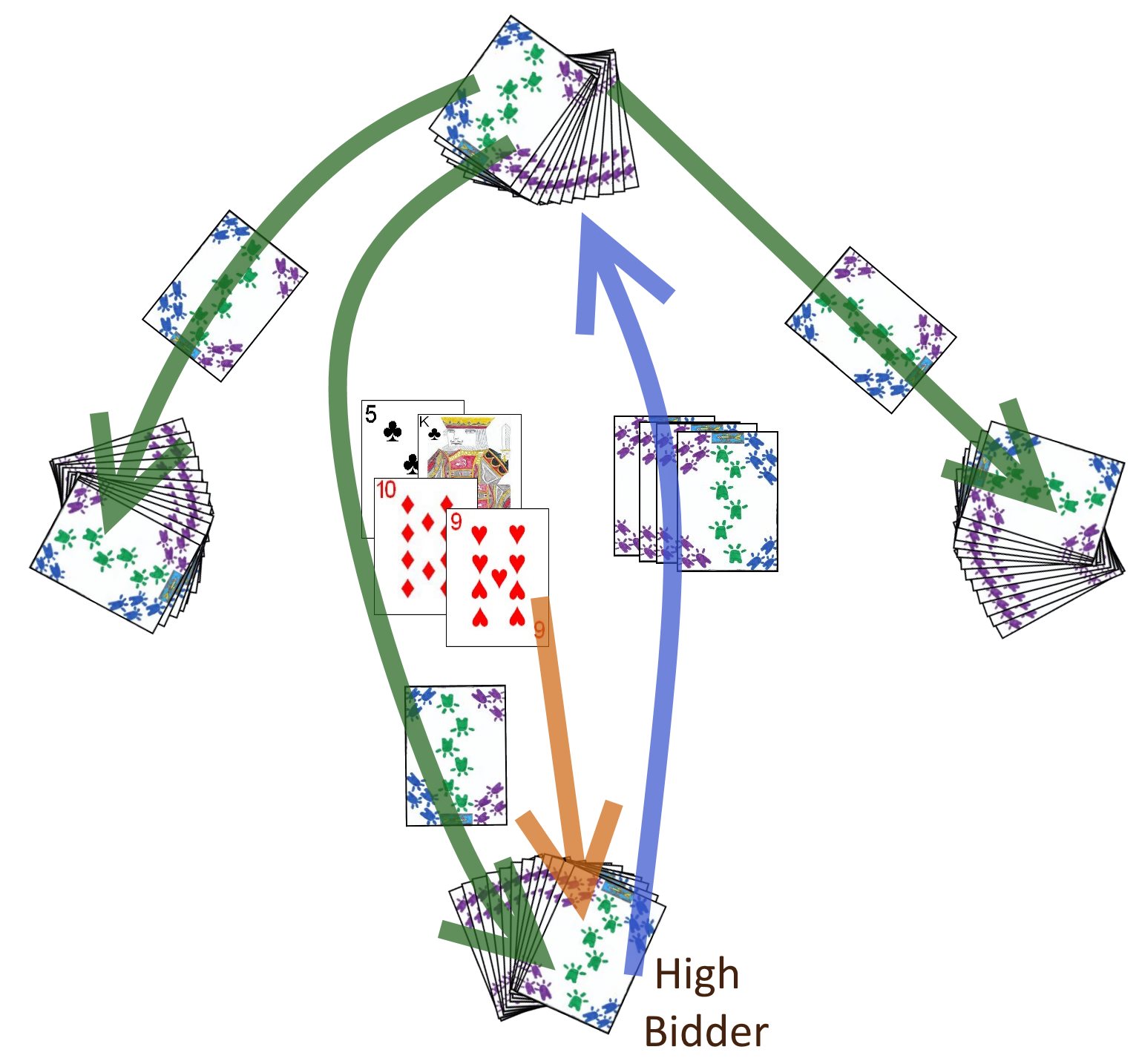 After the bidding, the high bidder then turns over the four cards which comprise the kitty on the table. After all players have the opportunity to view these cards, the high bidder then adds these four cards into his own hand. He then selects any four cards from his hand and passes them face-down to his partner who adds these passed cards to his own hand. The partner of the high bidder then passes one card face-down of his choice to each other player (including his partner). All passed cards are passed face-down such that no other
players can see what card or cards are passed. As opposed to games such as Bridge, which do not feature the passing of cards, the specific cards passed and the order of these cards can be used to convey information to his partner. As such, the high bidder can stack the four cards passed face down in any order before passing the four cards in a small stack to his partner.
After the bidding, the high bidder then turns over the four cards which comprise the kitty on the table. After all players have the opportunity to view these cards, the high bidder then adds these four cards into his own hand. He then selects any four cards from his hand and passes them face-down to his partner who adds these passed cards to his own hand. The partner of the high bidder then passes one card face-down of his choice to each other player (including his partner). All passed cards are passed face-down such that no other
players can see what card or cards are passed. As opposed to games such as Bridge, which do not feature the passing of cards, the specific cards passed and the order of these cards can be used to convey information to his partner. As such, the high bidder can stack the four cards passed face down in any order before passing the four cards in a small stack to his partner.
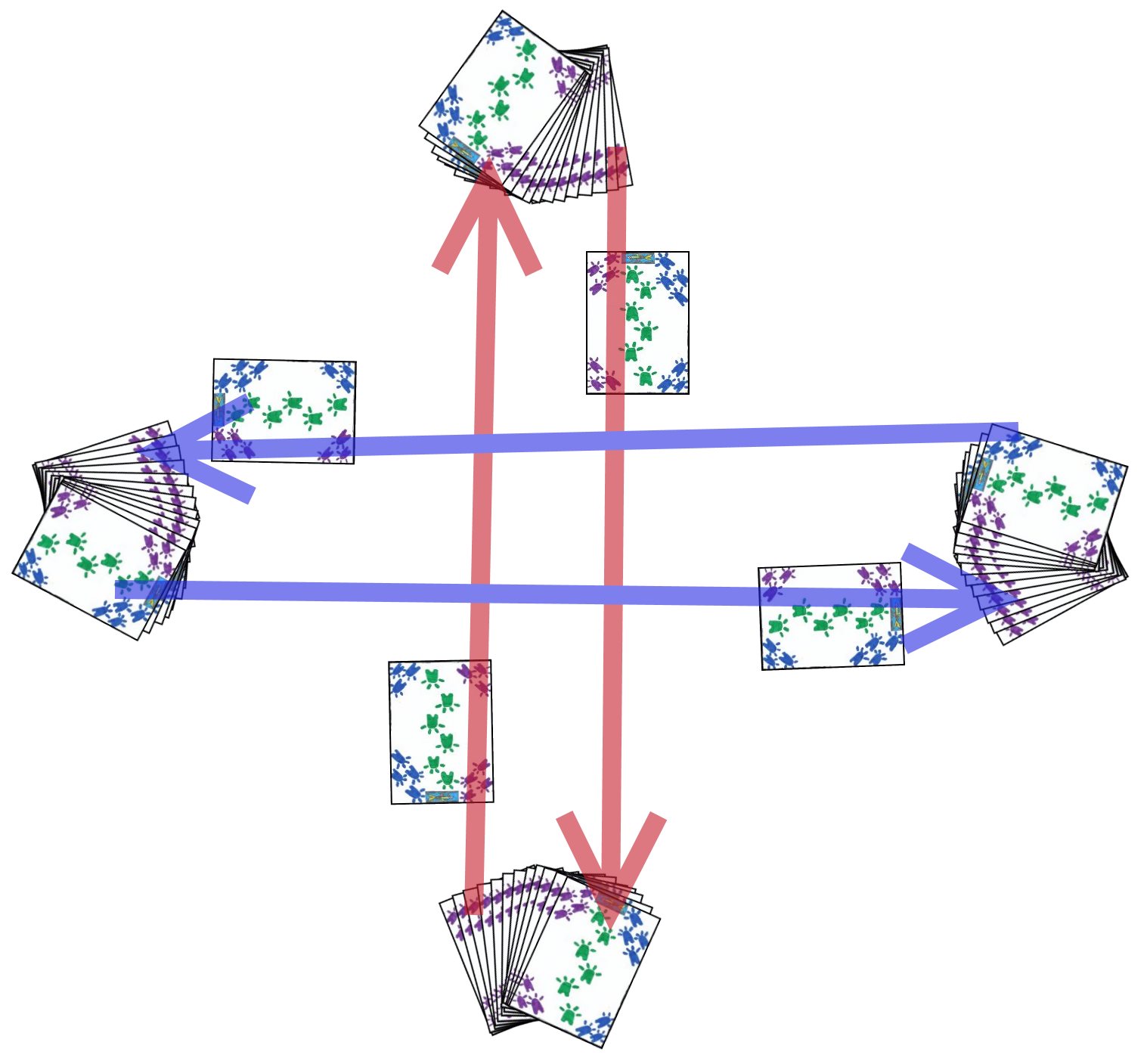 All Pass Misère: As mentioned in the sections below, if all players pass on the first round of bidding, the hand is played at All Pass Misère. This occurs in both kitty and eagle games. In the case of a kitty game which is to played at All Pass Misère the dealer distributes the four cards of the kitty clockwise around the table without looking at the cards. Each player selects one card of his choice from his hand and passes it face-down across the table to his partner before play of the hand begins. The partnership consisting of the dealer usually, by convention passes first and the opponents pass next.
All Pass Misère: As mentioned in the sections below, if all players pass on the first round of bidding, the hand is played at All Pass Misère. This occurs in both kitty and eagle games. In the case of a kitty game which is to played at All Pass Misère the dealer distributes the four cards of the kitty clockwise around the table without looking at the cards. Each player selects one card of his choice from his hand and passes it face-down across the table to his partner before play of the hand begins. The partnership consisting of the dealer usually, by convention passes first and the opponents pass next.
 The player who bid Bolshevik then turns over the four card kitty for all to see. After doing this he adds the cards to his own hand and then passes one card of his choice from his hand, face-down to each other player starting with the player to his immediate left. The Bolshevik bidding player then has two options, he may either continue play (standard Bolshevik), playing the hand at seven misère. However, he also has the option to increase the bid to seven (called Dictator) declaring a trump suit of his choice (or no-trump) and plays as if playing at a bid of seven using that trump suit.
The player who bid Bolshevik then turns over the four card kitty for all to see. After doing this he adds the cards to his own hand and then passes one card of his choice from his hand, face-down to each other player starting with the player to his immediate left. The Bolshevik bidding player then has two options, he may either continue play (standard Bolshevik), playing the hand at seven misère. However, he also has the option to increase the bid to seven (called Dictator) declaring a trump suit of his choice (or no-trump) and plays as if playing at a bid of seven using that trump suit.
 The player to the immediate left of the declarer leads the first card to the first trick. When leading to a trick, a player may lead with any card of his choice remaining in his hand. Each other player, in proper turn, then plays one card to the trick. When playing to a trick, a player must play a card of the same suit as originally played to the trick if he has one. If he does not have such a card he may play any card from his hand including a card of the trump suit.
The player to the immediate left of the declarer leads the first card to the first trick. When leading to a trick, a player may lead with any card of his choice remaining in his hand. Each other player, in proper turn, then plays one card to the trick. When playing to a trick, a player must play a card of the same suit as originally played to the trick if he has one. If he does not have such a card he may play any card from his hand including a card of the trump suit.
 Honor points can be scored for in several ways, including by being dealt honor cards. The honor cards are the Ace, King, Queen, Jack and 10 of the trump suit. In addition, the four Aces are also considered point scoring cards. If the winning bid was at No Trump, there are no specific honor cards, but the four Aces are still considered bonus point scoring cards. In suited bids, note that the Ace of the trump suit can potentially be scored for twice, once as an honor card and once as an Ace.
The honors are divided into two categories, Honor Cards and Aces. Each partnership should first determine the number of Honor Cards and Aces they have been dealt. Whichever total is higher would then be determined to be their total honors for the hand. Then, this total from both partnership should be compared and the partnership which has the higher total is entitled to score for Honors. This partnership scores a number of points equal to the difference between his partnerships Honor Cards they had been dealt and the opposing teams Honor cards they had been dealt, all multiplied by 100. In a hand in which the high bid was of "No Trump", only the four Aces are scored, with the side having been dealt the most Aces scoring a number of points equal to 250 times the number of Aces won in tricks during the current hand.
Honor points can be scored for in several ways, including by being dealt honor cards. The honor cards are the Ace, King, Queen, Jack and 10 of the trump suit. In addition, the four Aces are also considered point scoring cards. If the winning bid was at No Trump, there are no specific honor cards, but the four Aces are still considered bonus point scoring cards. In suited bids, note that the Ace of the trump suit can potentially be scored for twice, once as an honor card and once as an Ace.
The honors are divided into two categories, Honor Cards and Aces. Each partnership should first determine the number of Honor Cards and Aces they have been dealt. Whichever total is higher would then be determined to be their total honors for the hand. Then, this total from both partnership should be compared and the partnership which has the higher total is entitled to score for Honors. This partnership scores a number of points equal to the difference between his partnerships Honor Cards they had been dealt and the opposing teams Honor cards they had been dealt, all multiplied by 100. In a hand in which the high bid was of "No Trump", only the four Aces are scored, with the side having been dealt the most Aces scoring a number of points equal to 250 times the number of Aces won in tricks during the current hand.